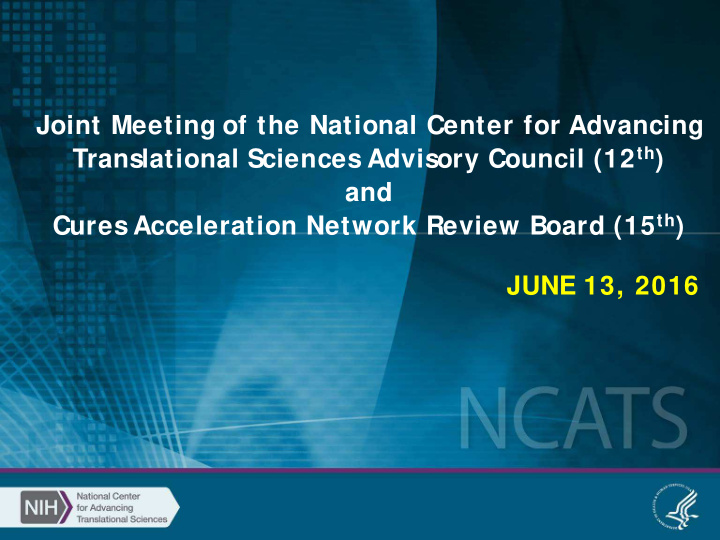



Joint Meeting of the National Center for Advancing Translational Sciences Advisory Council (12 th ) and Cures Acceleration Network Review Board (15 th ) JUNE 13, 2016
Open Session Agenda • Call to Order • Approval of Minutes • Confirmation of Future Meeting Dates • NCATS Director’s Report Presentation Discussion • Clearance of Concepts Presentations Discussion and Consideration 2
Future Meeting Dates Future Joint Meetings NCATS Advisory Council/CAN Review Board 2016 2017 2018 September 15 January 12 January 11 May 4 May 10 September 7 TBD Future CAN Review Board (only) Meetings (by phone) 2016 2017 2018 December 9 December 15 December 14 3
SEE NCATS DIRECTOR’S UPDATE 4
DISCUSSION 5
CLEARANCE OF CONCEPTS 6
Joint NCATS Advisory Council and Cures Acceleration Network Review Board June 13, 2016 Concept Clearance NIH/NCATS Registry Program Petra Kaufmann, M.D. Director, Office of Rare Diseases Research
NIH/NCATS Registry Program • Background Registry definition: A collection of standardized information about a group of patients who share a condition or experience. S ource: Data can come from patients, clinicians, electronic health records, etc. Registries can support the translational research process by Connecting potential participants to research studies (Contact Registry) Providing datasets for research on disease progression and for clinical trials (Natural history registry) The Office of Rare Diseases Research has supported registries through Developing common data elements (CDEs) Mapping data into a i2b2/ tranS MART data repository, working with investigators at Harvard University
NIH/NCATS Registry Program Goals: To promote high quality, standardized registries that are: patient centered feasible sustainable focused on therapeutics development consistent across the therapeutics development lifecycle data content, quality, format and transport standards
NIH/NCATS Registry Program • Description Developing data content and quality standards for registries Aligning with FDA data submission framework Implementing demonstration proj ects Disseminating tools, templates and standard processes for registries
Joint NCATS Advisory Council and Cures Acceleration Network Review Board June 13, 2016 Concept Clearance SBIR Contract Topic: Development of Drone Labware Lili M. Portilla, M.P.A. Director, Office of Strategic Alliances Sam Michael Director, Automation and Compound Management
Development of Drone Labware • Background There is a market opportunity for a small business to develop and eventually commercialize a lab drone for High Throughput S creening (HTS ) applications. Drones have a much greater range of motion than stationary robotic arms and they are cheaper to maintain. The open source community is constantly developing new tools to make drones more efficient and cheaper. In an HTS setting, it is difficult to have robotic arms in shared work spaces due to synchronization concerns and the possibility of collision. Lab drones can occupy the same air space, allowing for the coordination of multiple drones in the same work area. Use of lab drones can be transferable to other lab tasks, such as handling of hazardous materials.
Development of Drone Labware • Goal To develop an autonomous drone capable of taking a laboratory consumable (e.g. well-plate) from one station to another in a consistent and reproducible manner. • Potential impact (including relevance to NCATS ’ mission) There is impact for a small business to develop a lab drone system using open source/ crowd sourcing software, thereby creating a new market niche to make fully automated HTS laboratory operations more accessible to labs not currently equipped or funded to do so. • Criteria for evaluating success S BIR contract mechanism will support and monitor milestones and deliverables delineated in the contract S tatement of Work.
Joint NCATS Advisory Council and Cures Acceleration Network Review Board June 13, 2016 Concept Clearance NIH-CASIS Coordinated Program in Tissue Chip Systems for Translational Research in Space Danilo A. Tagle, Ph.D. Associate Director for Special Initiatives
NIH-CASIS Coordinated Program in Tissue Chip Systems for Translational Research in Space • Goal NCATS has established a MOU with the Center for the Advancement of S cience in S pace (CAS IS ) to deploy and further develop tissue chip technology platforms for biomedical research at the International S pace S tation (IS S ) that will lead to a better understanding of the molecular basis of human disease and/ or the effectiveness of diagnostic markers and therapeutic interventions. • Brief description of outcome Among the areas of research encouraged in this initiative is translational research examining the mechanisms that underlie the effects of diseases or conditions associated with bone and cartilage, skeletal muscle, brain, gastrointestinal tract, lung, liver, skin, microvasculature, or other tissues, as well as research designed to improve the translation of existing knowledge of strategies for the prevention and treatment of such diseases or conditions.
NIH-CASIS Coordinated Program in Tissue Chip Systems for Translational Research in Space • Potential impact Better understanding of microgravity, reduced-gravity environments at the IS S and radiation exposure and its effects on many of the human body's systems. It is now widely known that accelerated aging takes place in space due to muscle wasting, osteoporosis, reduced cardiopulmonary function, immune response, etc, but that these conditions are reversible when astronauts return to Earth. • Criteria for evaluating success Better insight into the molecular basis, including epigenome changes, for many human conditions in space and new information for novel targets for drug development for use on Earth
NIH-CASIS Coordinated Program in Tissue Chip Systems for Translational Research in Space • What is the maj or obstacle to address? Pushing the limits of tissue chip technology for use in space, including microfluidics, bioreactors, remote sensing, and ground control capabilities through successful collaborations between NIH-supported tissue chip developers and CAS IS implementation partners • Brief summary of ongoing research/ activity in this area? Prior investment by NIH (NCATS through CAN, NIH Common Fund, NIBIB, NIEHS , NIDCD, NIDDK, NCI, OR WH) in developing tissue chip technology for drug safety and efficacy testing
DISCUSSION AND CONSIDERATION 18
OPEN SESSION ADJOURNMENT 19
Recommend
More recommend